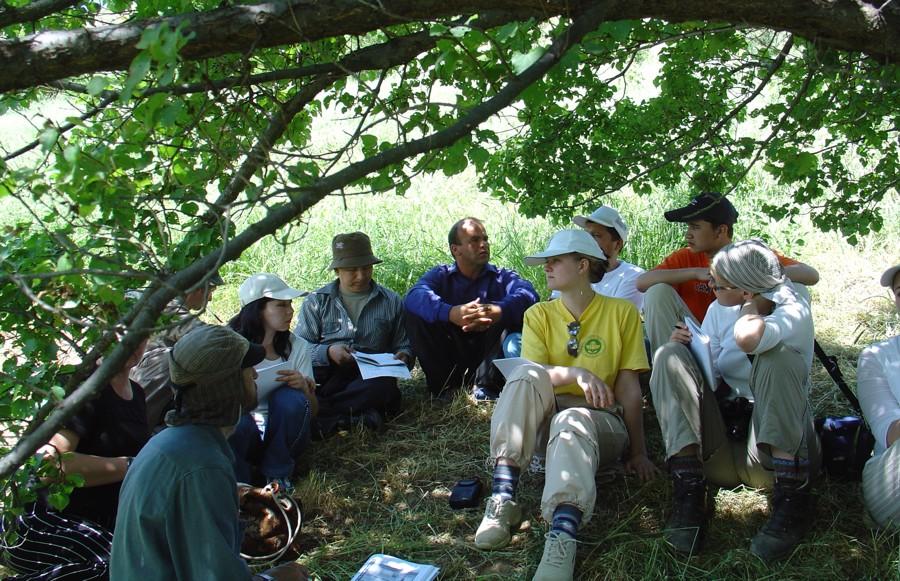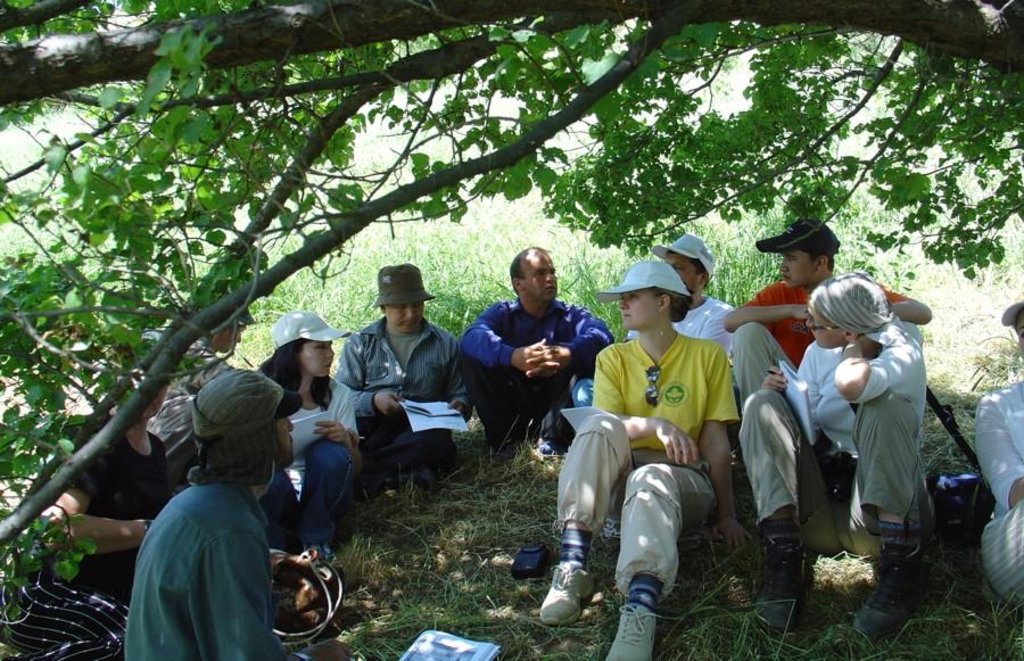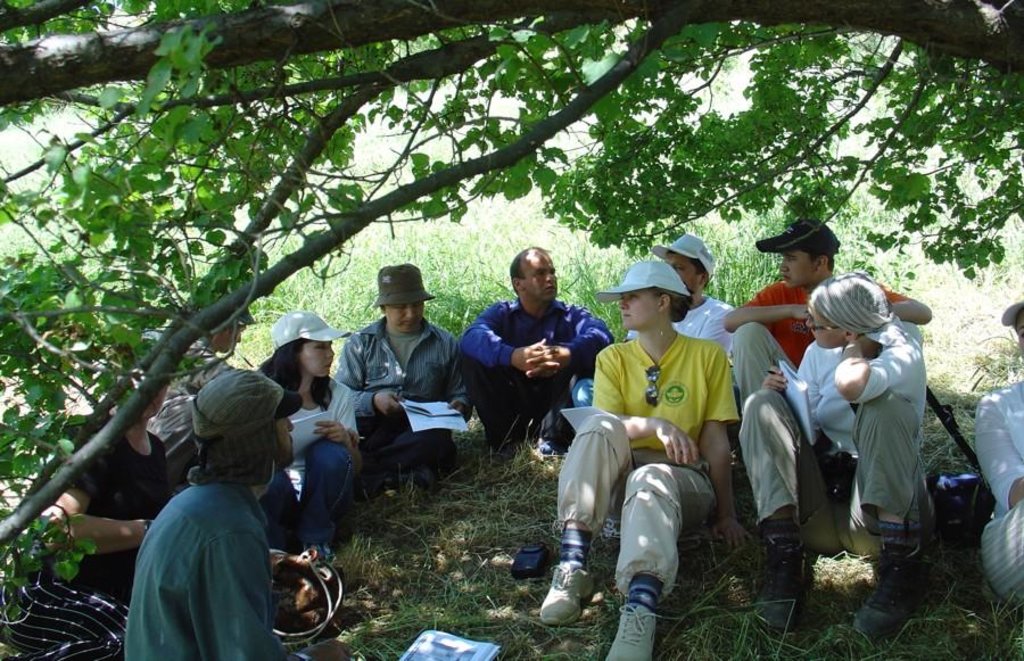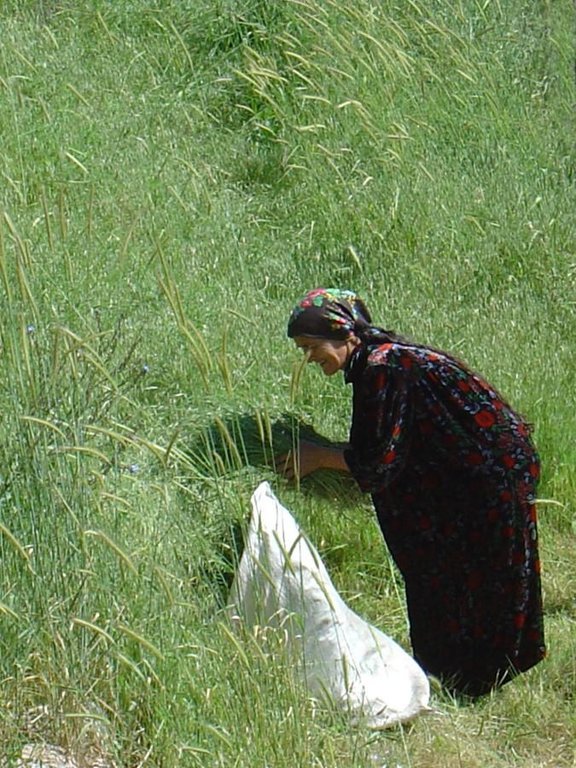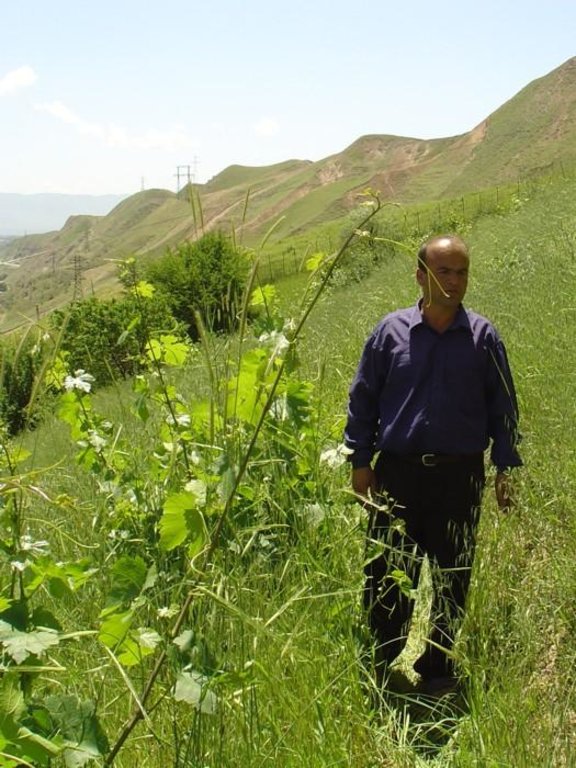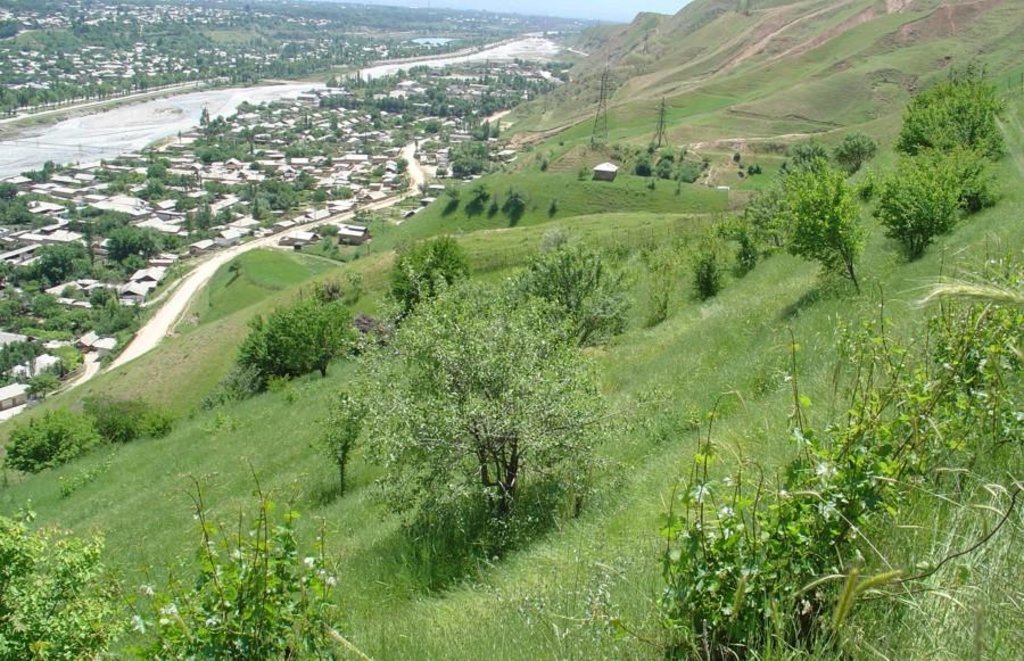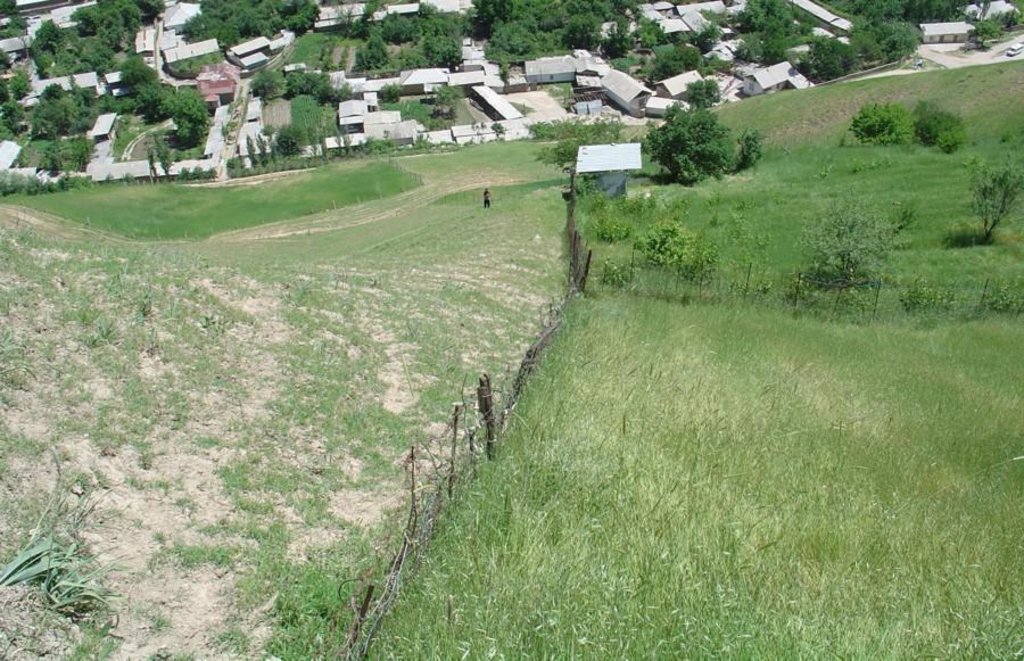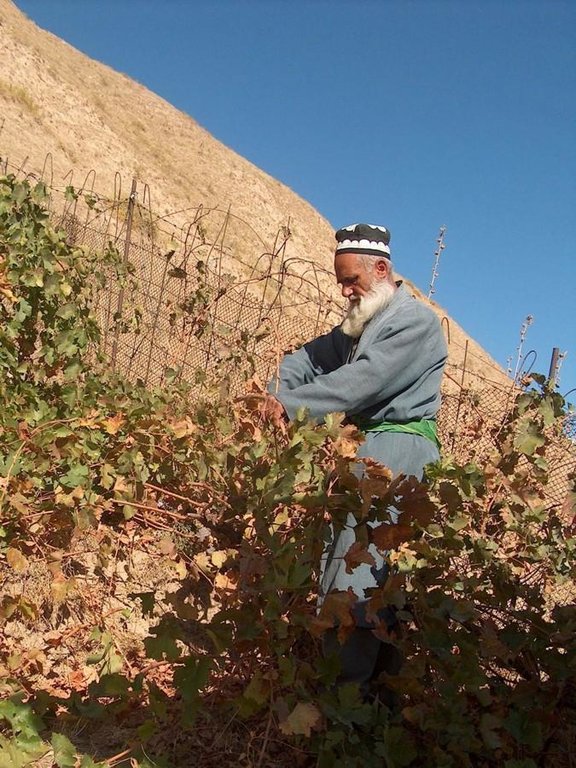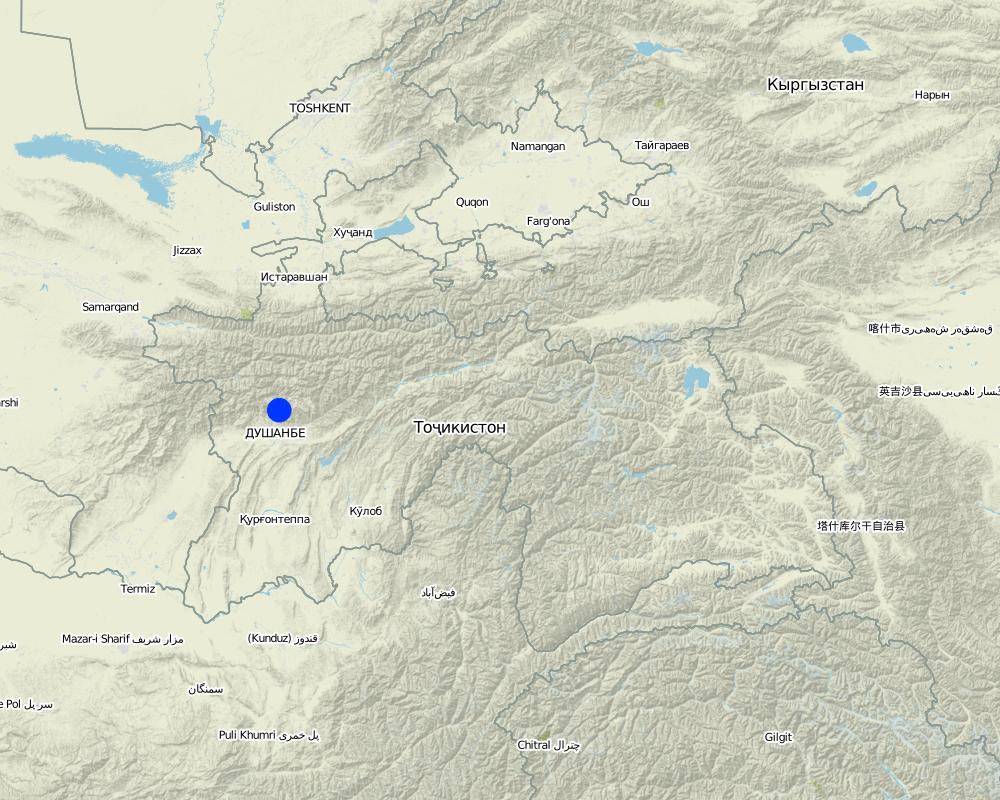Farmer innovation and self-help group [ຕາຈິກິສະຕານ]
- ການສ້າງ:
- ປັບປູງ:
- ຜູ້ສັງລວມຂໍ້ມູນ: Murod Ergashev
- ບັນນາທິການ: –
- ຜູ້ທົບທວນຄືນ: Alexandra Gavilano, David Streiff
approaches_2661 - ຕາຈິກິສະຕານ
- ສະຫຼຸບສັງລວມຢ່າງທັງໝົດທີ່ເປັນ PDF
- ສັງລວມເປັນບົດ PDF ເພື່ອສັ່ງພິມ
- ສັງລວມເປັນບົດ ຢູ່ໃນ browser
- ບົດສະຫຼຸບ ສະບັບເຕັມ (ບໍ່ມີແບບຟອມ)
- Farmer innovation and self-help group: Nov. 2, 2021 (public)
- Farmer innovation and self-help group: April 4, 2018 (inactive)
- Farmer innovation and self-help group: Aug. 8, 2017 (inactive)
- Farmer innovation and self-help group: Aug. 7, 2017 (inactive)
- Farmer innovation and self-help group: July 5, 2017 (inactive)
ເບິ່ງພາກສ່ວນ
ຂະຫຍາຍທັງໝົດ ຍຸບທັງໝົດ1. ຂໍ້ມູນທົ່ວໄປ
1.2 ລາຍລະອຽດ ການຕິດຕໍ່ ຂອງບຸກຄົນທີ່ຊັບພະຍາກອນ ແລະ ສະຖາບັນ ການມີສ່ວນຮ່ວມ ໃນການປະເມີນຜົນ ແລະ ເອກະສານ ຂອງວິທີທາງ
ຜູ້ນໍາໃຊ້ທີ່ດິນ:
Sharif Aliev family
Khagatai Village, Rayon of Varzob
ຕາຈິກິສະຕານ
ຊື່ຂອງ ສະຖາບັນການຈັດຕັ້ງ ທີ່ອໍານວຍຄວາມສະດວກ ໃນການສ້າງເອກກະສານ ຫຼື ປະເມີນແນວທາງ (ຖ້າກ່ຽວຂ້ອງ)
CAMP - Central Asian Mountain Partnership (CAMP - Central Asian Mountain Partnership) - ກີກັດຕັນ1.3 ເງື່ອນໄຂ ຂອງການນໍາໃຊ້ເອກກະສານຂໍ້ມູນ ຂອງ WOCAT
ຜູ້ສັງລວມ ແລະ ບັນດາຜູ້ຕອບແບບສອບຖາມ ຍອມຮັບໃນເງື່ອນໄຂ ການນໍາໃຊ້ຂໍ້ມູນເອກະສານ ທີ່ສ້າງຂື້ນ ໂດຍຜ່ານ ອົງການ WOCAT:
ແມ່ນ
1.4 ເອກະສານອ້າງອີງ (ຫຼາຍ) ກັບແບບສອບຖາມ (ຫຼາຍ) ເຕັກໂນໂລຢີ ຂອງດ້ານການຄຸ້ມຄອງ ດິນແບບຍືນຍົງ
2. ພັນລະນາ ແນວທາງການຄຸ້ມຄອງນໍາໃຊ້ດິນແບບຍືນຍົງ
2.1 ການອະທິບາຍ ໂດຍຫຍໍ້ ຂອງວິທີທາງ
An innovative land user, assisted by a self-help group has overcome many administrative and technical problems to establish a fruit garden on previously degraded communal grazing land.
2.2 ການອະທິບາຍ ລາຍລະອຽດ ຂອງວິທີທາງ
ການອະທິບາຍ ລາຍລະອຽດ ຂອງວິທີທາງ:
Aims / objectives: Although in the 1980s the soviet government supported the establishment of private gardens in specified areas, the lack of irrigation water and suitable land often restricted this process. That was the case for Khagatai village, situated on the narrow valley floor of the Varzob River, below steep loess slopes. This marginal area is used for grazing and shows severe signs of water erosion; the hillsides are considered to be of little agricultural value. In the early 1980s, widespread unemployment evidently had the effect of stimulating people to use their own initiative. In 1982, one innovative farmer started to fence-off an area of half a hectare to establish a private fruit garden on the degraded grazing land. Some say that the fencing of plots for private fruit and hay production is a traditional practice - abandoned after the 1950s - but taken up again recently to re-establish rights to individual plots. The practice is widespread in the higher villages of Varzob, where the farmer noted it and decided to set up his own plot. When it came to practical implementation, despite the land user having five sons, the labour-intensive terracing was only completed thanks to the voluntary assistance of relatives and friends, a tradition locally known as 'hashar'. At first, when his initiative began to take shape on land officially owned by a state farm, no action was taken. However, the change in land management quickly showed positive productive results, and it may have been through jealousy that the people of Khagatai village then reported the case to the authorities. The watering of the garden on the unstable loess slope in the immediate vicinity of the village, and the consequent risk of landslides, was put forward as the reason for the complaint. The authorities opened an investigation and a number of newspaper articles were written about the case.
Methods: Since independent decision making was not common in the soviet states, and rapid degradation of newly irrigated lands on the loess deposits was a big issue, the case of this fruit garden attracted a lot of attention. However, when they observed the improved state of the vegetation on the plot, the authorities finally allowed the farmer to continue. In 1993 the prohibition on private cultivation of land was lifted in order to reduce problems of food shortage caused during the civil war that followed independence. It was during this time that four other land users from Khagatai village spontaneously began to imitate this practice.
2.3 ຮູບພາບຂອງແນວທາງ
2.5 ປະເທດ / ເຂດ / ສະຖານທີ່ບ່ອນທີ່ແນວທາງໄດ້ຖືກນໍາໃຊ້
ປະເທດ:
ຕາຈິກິສະຕານ
ພາກພື້ນ / ລັດ / ແຂວງ:
Khagatai
ຂໍ້ມູນເພີ່ມເຕີມຂອງສະຖານທີ່:
Varzob
Map
×2.6 ວັນທີເລີ່ມຕົ້ນ ແລະ ສິ້ນສຸດ ການຈັດຕັ້ງປະຕີບັດ ວິທີທາງ
ສະແດງປີຂອງການເລີ່ມຕົ້ນ:
1982
2.7 ປະເພດຂອງແນວທາງ
- ພື້ນເມືອງ / ທ້ອງຖີ່ນ
2.8 ເປົ້າໝາຍ / ຈຸດປະສົງຫຼັກ ຂອງການຈັດຕັ້ງປະຕິບັດ ວິທີທາງ
To establish an orchard with grape vines, fruit trees and fodder crops for private use.
The SLM Approach addressed the following problems: The land in question is part of a communal grazing area and property rights are officially with Khagatai village (in Soviet times with a state farm). Uncontrolled grazing on communal lands has resulted in overgrazing, and thus to progressive water erosion on the steep loess deposits. No attention was paid by the local authorities to soil and water conservation measures in areas considered to be of low agricultural potential.
2.9 ເງື່ອນໄຂອໍານວຍ ຫຼື ຂັດຂວາງການປະຕິບັດຂອງເຕັກໂນໂລຢີ / ເຕັກໂນໂລຢີການນໍາໃຊ້ຕາມແນວທາງ
ສັງຄົມ / ວັດທະນະທໍາ / ມາດຕະຖານ ແລະ ຄຸນຄ່າທາງສາສະໜາ
- ເຊື່ອງຊ້ອນ
Jealousy of other village members, who didn't like another land user fencing off a plot in communal grazing land.
Treatment through the SLM Approach: Others became convinced after the change in land use. Newspaper articles on the case also helped to form public opinion.
ມີຄວາມສາມາດ / ເຂັ້າເຖິງຊັບພະຍາກອນດ້ານການເງິນ ແລະ ການບໍລິການ
- ເຊື່ອງຊ້ອນ
All inputs had to be provided by the land user himself.
Treatment through the SLM Approach: Creative ways were developed to provide material for fencing, for transportation of irrigation water and for access to manure.
ການກໍ່ຕັ້ງສະຖາບັນ
- ເຊື່ອງຊ້ອນ
Private initiatives on state land were not encouraged under the soviet system.
Treatment through the SLM Approach: Activities tended to start on marginal land that was of little agronomic interest to state farms.
ກ່ຽວກັບກົດໝາຍ (ສິດນໍາໃຊ້ດິນ, ສິດນໍາໃຊ້ນໍ້າ)
- ເຊື່ອງຊ້ອນ
No individual property rights.
Treatment through the SLM Approach: In soviet times the land belonged to a state farm. Today the land belongs to Khagatai village: efforts to achieve official
ຄວາມຮູ້ກ່ຽວກັບການຄຸ້ມຄອງ ທີ່ດິນແບບຍືນຍົງ, ການເຂົ້າເຖິງການສະໜັບສະໜູນ ທາງດ້ານວິຊາການ
- ເຊື່ອງຊ້ອນ
For the establishment of the orchard irrigation water was needed. This had to be brought 200 m up a steep slope.
Treatment through the SLM Approach: Water in old inner tubes was transported to the orchard by donkey.
ອື່ນໆ
- ເຊື່ອງຊ້ອນ
Availability of labour: Construction of terraces for tree planting is very labour intensive.
Treatment through the SLM Approach: Voluntary work of relatives and friends.
3. ການມີສ່ວນຮ່ວມ ແລະ ບົດບາດຂອງພາກສ່ວນທີ່ກ່ຽວຂ້ອງທີ່ໄດ້ມີສ່ວນຮ່ວມ
3.1 ຜູ້ມີສ່ວນຮ່ວມ ໃນວິທີທາງ ແລະ ພາລະບົດບາດ ຂອງເຂົາເຈົ້າ
- ຜູ້ນໍາໃຊ້ດິນໃນທ້ອງຖິ່ນ / ຊຸມຊົນທ້ອງຖິ່ນ
Mainly men participated: Women are not usually expected to carry out field activities for cultural reasons. The coffee harvest is the only activity where men and women work together in the field.
3.2 ການມີສ່ວນຮ່ວມຂອງຜູ້ນໍາໃຊ້ທີ່ດິນໃນທ້ອງຖິ່ນ / ຊຸມຊົນທ້ອງຖິ່ນໃນໄລຍະທີ່ແຕກຕ່າງກັນຂອງແນວທາງ
| ການລວບລວມ ເອົາຜູ້ນໍາໃຊ້ດິນ ໃນທ້ອງຖິ່ນ / ຊຸມຊົນທ້ອງຖິ່ນ | ໃຫ້ລະບຸ ຜູ້ໃດທີ່ມີສ່ວນຮ່ວມ ໃນແຕ່ລະກິດຈະກໍາ? | |
|---|---|---|
| ການເລີ່ມຕົ້ນ / ແຮງຈູງໃຈ | ການນໍາໃໍຊ້ເອງ | individual land user; the initiative was initiated by an individual land user |
| ການວາງແຜນ | ການນໍາໃໍຊ້ເອງ | step by step |
| ການປະຕິບັດ | ການນໍາໃໍຊ້ເອງ | land user; the project was implemented by the individual land user, relatives and neighbours participated voluntarily in terrace construction |
| ຕິດຕາມກວດກາ / ການປະເມີນຜົນ | ການນໍາໃໍຊ້ເອງ | by the individual land user; the project is monitored and evaluated by the individual land user |
| Research | ການຮ່ວມມື | post-implementation documentation (participatory) |
3.4 ການຕັດສິນໃຈກ່ຽວກັບການຄັດເລືອກເຕັກໂນໂລຢີຂອງການຄຸ້ມຄອງທີ່ດິນແບບຍືນຍົງ / ເຕັກໂນໂລຢີ
ລະບຸ ຄົນທີ່ຕັດສິນໃຈ ກ່ຽວກັບການຄັດເລືອກຂອງ ເຕັກໂນໂລຢີ / ເຕັກໂນໂລຢີ ຈະໄດ້ຮັບການປະຕິບັດ:
- ຜູ້ນໍາໃຊ້ດິນຜູ້ດຽວ (ການລິເລີ່ມດ້ວຍຕົນເອງ)
ອະທິບາຍ:
Decisions on the method of implementing the SLM Technology were made by by land users alone (self-initiative / bottom-up)
4. ການສະໜັບສະໜູນທາງດ້ານວິຊາການ, ການສ້າງຄວາມສາມາດ, ແລະ ການຈັດການຄວາມຮູ້.
4.1 ການສ້າງຄວາມສາມາດ / ການຝຶກອົບຮົມ
ຜູ້ນໍາໃຊ້ທີ່ດິນ ຫຼື ພາກສ່ວນກ່ຽວຂ້ອງອື່ນໆ ໄດ້ຮັບການຝຶກອົບຮົມບໍ່?
ບໍ່ແມ່ນ
4.2 ການບໍລິການໃຫ້ຄໍາປຶກສາ
ເຮັດຜູ້ໃຊ້ທີ່ດິນມີການເຂົ້າເຖິງການບໍລິການໃຫ້ຄໍາປຶກສາ?
ແມ່ນ
- through interaction of land users
ອະທິບາຍ / ຄວາມຄິດເຫັນ:
Key elements: Observations, farmer-to-farmer exchange of ideas.
4.3 ສະຖາບັນການສ້າງຄວາມເຂັ້ມແຂງ (ການພັດທະນາອົງການຈັດຕັ້ງ)
ສະຖາບັນ ໄດ້ຮັບການສ້າງຕັ້ງຂື້ນ ຫຼື ໄດ້ຮັບການສ້າງຄວາມເຂັ້ມແຂງ ໂດຍການຈັດຕັ້ງປະຕິບັດ ວິທີທາງບໍ່?
- ບໍ່ມີ
4.4 ຕິດຕາມກວດກາ ແລະ ປະເມີນຜົນ
ການຈັດຕັ້ງປະຕິບັດ ວິທີທາງ ໄດ້ມີການປະເມີນຜົນ ແລະ ຕິດຕາມບໍ?
ແມ່ນ
ຄວາມຄິດເຫັນ:
Bio-physical aspects were ad hoc monitored by land users through observations; indicators: growth of seedlings
Economic / production aspects were ad hoc monitored by 0 through observations; indicators: comparison of yields between different years
no. of land users involved aspects were ad hoc monitored by 0 through observations; indicators: None
There were few changes in the Approach as a result of monitoring and evaluation: There were a few changes due to the observations made by the land user: he started to apply supplementary irrigation to the tree seedlings, as well as applying manure each year.
4.5 ການຄົ້ນຄວ້າ
ນີ້້ແມ່ນສ່ວນໜຶ່ງ ການຄົ້ນຄວ້າ ຂອງວິທີທາງບໍ່?
ແມ່ນ
ໃຫ້ຂໍ້ມູນ ເພີ່ມເຕີມ ແລະ ກໍານົດ ຜູ້ໃດເຮັດການຄົ້ນຄວ້າ:
There had been no research until the identification and documentation of this initiative through a Tajik-Swiss project under the framework of the National Centre of Competence in Research (NCCR) North-South (coordinated by the the Centre for Development and Environment, Switzerland).
5. ການສະໜັບສະໜູນທາງດ້ານການເງິນ ແລະ ອຸປະກອນຈາກພາຍນອກ
5.1 ງົບປະມານປະຈໍາປີ ສໍາລັບວິທີທາງ ຂອງການຄຸ້ມຄອງ ທີ່ດິນແບບຍືນຍົງ
ຄໍາເຫັນ (ຕົວຢ່າງ: ແຫຼ່ງຂໍ້ມູນຫຼັກ ຂອງການສະໜອງທຶນ / ຜູ້ໃຫ້ທຶນທີ່ສໍາຄັນ):
Approach costs were met by the following donors: other (land user/private): 100.0%
5.2 ການສະໜັບສະໜູນ ທາງດ້ານການເງິນ / ອຸປະກອນ ສະໜອງໃຫ້ແກ່ຜູ້ນໍາທີ່ດິນ
ຜູ້ນໍາໃຊ້ດິນ ໄດ້ຮັບການສະໜັບສະໜູນ ທາງດ້ານ ການເງິນ / ອຸປະກອນ ໃນການຈັດຕັ້ງປະຕິບັດ ເຕັກໂນໂລຢີບໍ?
ບໍ່ແມ່ນ
5.3 ເງິນສົມທົບສໍາລັບການນໍາໃຊ້ສະເພາະປັດໃຈຂາເຂົ້າໃນການຜະລີດກະສິກໍາ (ລວມທັງແຮງງານ)
ຄວາມຄິດເຫັນ:
All the inputs were fully financed by the land user himself. This included hand tools, fruit tree seedlings, vines, manure, supplementary irrigation, water transport by donkey and by car.
5.4 ສິນເຊື່ອ
ໄດ້ປ່ອຍສິນເຊື່ອ ສະໜອງໃຫ້ພາຍໃຕ້ ວິທີການສໍາລັບກິດຈະກໍາ ການຄຸ້ມຄອງ ທີ່ດິນແບບຍືນນຍົງບໍ່?
ບໍ່ແມ່ນ
5.5 ສິ່ງຈູງໃຈ ຫຼື ເຄື່ອງມືອື່ນໆ
ການສົ່ງເສີມ ຈັດຕັ້ງປະຕິບັດ ເຕັກໂນໂລຢີ ໃນການຄຸ້ມຄອງ ດິນແບບຍືນຍົງ ໄດ້ສະໜອງສິ່ງກະຕຸກຊຸກຍູ້ບໍ່?
ບໍ່ແມ່ນ
6. ວິເຄາະຜົນກະທົບ ແລະ ສັງລວມບັນຫາ
6.1 ຜົນກະທົບຂອງແນວທາງ
ການຈັດຕັ້ງປະຕິບັດ ວິທີທາງ ສາມາດຊ່ວຍຜູ້ນໍາໃຊ້ທີ່ດິນ ໃນການຈັດຕັ້ງປະຕິບັດ ແລະ ບໍາລຸງຮັກສາ ເຕັກໂນໂລຢີ ການຄຸ້ມຄອງ ທີ່ດິນແບບຍືນຍົງໄດ້ບໍ?
- ບໍ່
- ມີ, ໜ້ອຍໜຶ່ງ
- ມີ, ພໍສົມຄວນ
- ມີ, ຫຼາຍ
There has been a significant, though localised, improvement in soil and water management.
ການຈັດຕັ້ງປະຕິບັດ ວິທີທາງ ສາມາດສ້າງຄວາມເຂັ້ມແຂງ ທາງສັງຄົມ ແລະ ເສດຖະກິດບໍ່?
- ບໍ່
- ມີ, ໜ້ອຍໜຶ່ງ
- ມີ, ພໍສົມຄວນ
- ມີ, ຫຼາຍ
Did other land users / projects adopt the Approach?
- ບໍ່
- ມີ, ໜ້ອຍໜຶ່ງ
- ມີ, ພໍສົມຄວນ
- ມີ, ຫຼາຍ
Other land users from Khagatai village have adopted the system on the same hillside. They started fencing-off plots in the 1990s during the civil war. At that time many people were unemployed, and labour was therefore available. Furthermore there was a shortage in food supplies and people relied on . It was very unusual during the soviet times for a villager to take the initiative to establish a private plot on state land. However in this example, the success in establishing a vineyard on an overgrazed hill convinced the administration of its worth. Other land users have now followed this approach.
Did the Approach lead to improved livelihoods / human well-being?
- ບໍ່
- ມີ, ໜ້ອຍໜຶ່ງ
- ມີ, ພໍສົມຄວນ
- ມີ, ຫຼາຍ
Did the Approach help to alleviate poverty?
- ບໍ່
- ມີ, ໜ້ອຍໜຶ່ງ
- ມີ, ພໍສົມຄວນ
- ມີ, ຫຼາຍ
6.2 ແຮງຈູງໃຈຫຼັກຂອງຜູ້ນໍາໃຊ້ທີ່ດິນໃນການປະຕິບັດການຄຸ້ມຄອງທີ່ດິນແບບຍືນຍົງ
- ການຜະລິດເພີ່ມຂຶ້ນ
- ຄວາມຮັບຮູ້ ທາງສີ່ງແວດລ້ອມ
- well-being and livelihoods improvement
6.3 ຄວາມຍືນຍົງຂອງກິດຈະກໍາວິທີທາງ
ຜູ້ນໍາໃຊ້ ທີ່ດິນ ສາມາດສືບຕໍ່ ການຈັດຕັ້ງປະຕິບັດ ຜ່ານວິທີທາງໄດ້ບໍ່ (ໂດຍປາດສະຈາກ ການຊ່ວຍເຫຼືອ ຈາກພາກສ່ວນພາຍນອກ)?
- ແມ່ນ
ຖ້າ ໄດ້, ອະທິບາຍເຫດຜົນ:
Because this approach is based on local initiatives there is no reason why it should not be sustainable. The insecure land use rights are the only potential risk to the continuation of the activities.
6.4 ຈຸດແຂງ / ຂໍ້ດີ ຂອງວິທີທາງ
| ຈຸດແຂງ / ຂໍ້ດີ / ໂອກາດໃນການນໍາໃຊ້ທີ່ດິນ |
|---|
| Rehabilitation of marginal land for production and generation of additional income. (How to sustain/ enhance this strength: Give property rights to land users to motivate further investments in soil and water conservation/production.) |
| ຈຸດແຂງ / ຈຸດດີ / ໂອກາດ ຈາກທັດສະນະຂອງຜູ້ປ້ອນຂໍ້ມູນ ຫຼື ບຸກຄົນສຳຄັນ |
|---|
| Bottom-up approach: independent decision making by the individual land user based on dynamic and flexible responses as required. (How to sustain/ enhance this strength: Give property rights to land users to motivate further investments in soil and water conservation/production.) |
6.5 ຈຸດອ່ອນ / ຂໍ້ເສຍຂອງແນວທາງ ແລະ ວິທີການແກ້ໄຂໃຫ້ເຂົາເຈົ້າ
| ຈຸດອ່ອນ ຫຼື ຂໍ້ເສຍ ຫຼື ຄວາມສ່ຽງ ໃນມຸມມອງຂອງ ຜູ້ສັງລວມຂໍ້ມູນ ຫຼື ບັນດາຜູ້ຕອບແບບສອບຖາມ | ມີວິທີການແກ້ໄຂຄືແນວໃດ? |
|---|---|
| Current systems of land ownership, currently the land belongs to Khagatai. | Provide land ownership to the farmers. |
| Not all farmers can apply this technology since it is location specific. | Identify if fodder production (cut-and-carry) would be more attractive than open grazing; allocate land to the farmers. |
| Only families with sufficient labour resources can establish such a garden by themselves. | Incentives from the state or other organisations are needed. |
| Since it is an initiative of an individual land user, the SWC technology has not been documented so far, nor evaluated, and lessons learned have not been spread among the land users. | Documentation and spreading of lessons learned. |
ຂໍ້ມູນການເຊື່ອມຕໍ່ ແລະ ເນື້ອໃນ
ຂະຫຍາຍທັງໝົດ ຍຸບທັງໝົດການເຊື່ອມຕໍ່
ບໍ່ມີຂໍ້ມູນການເຊື່ອມຕໍ່
ເນື້ອໃນ
ບໍ່ມີເນື້ອໃນ


